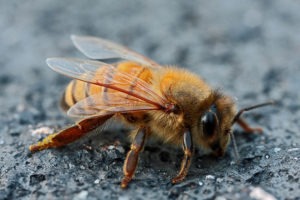Several times this summer, someone has asked me about bees around a garbage can. Each time the bees were honey bees and the garbage can was a public trash can located outside. The bees are being attracted to the half-drunk sodas that people toss into the trash without thinking about it. The problem is especially bad during the summer and sometimes into the early fall.
Many of the plants that bloom during Kentucky’s summer don’t produce much nectar that honey bees can use. Beekeepers call this time the summer dearth because there of the lack of natural food for the bees. Often, beekeepers will feed their bees sugar water to help them get through the summer dearth.

Sodas are full of high fructose corn syrup which is a sugar. When a bee finds a trash can full of half-drunk sodas, it thinks it has hit the sugar water jackpot. The bee loads up, rushes back to its hive, tells all of its sisters, and everyone makes a beeline for the trash can or recycling bin. This creates quite a buzz with sometimes hundreds of bees flying around the trash can.
This is why you sometimes see so many bees around the trash cans at gas stations. The gas station trash cans are right next to the pumps where it is very easy to toss a half-empty bottle of soda or a cup with the last watered down swallow of soda from a fast food joint. And the problem isn’t restricted to gas stations. The same thing happens at public trash cans at local parks, schools, universities, and other similar locations.
All of the bees flying around the trash can often results in complaints from the patrons. Those complaints can result at best in patrons not coming back for fear of getting stung, and at worst a lawsuit if someone who is allergic gets stung. Understandably, the owner / administrator feels like they must do something to minimize the risks to their patrons, themselves, and their business. “Doing something” usually means spraying the bees in an attempt to kill them and alleviate the perceived problem.
Most people don’t want to kill honey bees either directly or indirectly. The thought that tossing the remainder of a soda into the trash could result in a honey bee death sentence never even enters their minds. Luckily, the solution is relatively easy. All a person has to do is rinse the can, bottle, or cup out before throwing it away. (Or better yet, rinse out the container and then recycle it if possible. That way you are saving honey bees and landfill space.)
Rinsing the container gets rid of the majority of the leftover soda and greatly dilutes any last little bits that left in the container. It is important to rinse out even that last little swallow that is almost impossible to get out no matter how far up you tip the can or bottle. While that tiny bit by itself may not be enough to draw bees, it doesn’t take long before those little bits add up around a public trash can where lots of people are tossing their soda containers.
If you can’t rinse the container, dump as much of the remaining liquid as you can onto the grass a good distance away from the recycling bin or trash can. That will at least help keep from concentrating the bees in one area and the soda will soak into the ground instead of being held in the trash can. Another solution is to simply hang onto the container until you get somewhere that you can rinse it and dispose of it properly. Bees of all types have enough problems staying alive without us unintentionally creating situations that are unsafe for them and for other people.

This article was part of Shannon’s original Kentucky Pollinators and Backyard Wildlife blog which evolved into the blog for Backyard Ecology.

Backyard Ecology: Exploring Nature in Your Backyard
Nature isn’t just “out there.” It’s all around us, including right outside our doors. Hi, my name is Shannon Trimboli, and I am the host of Backyard Ecology. I live in southcentral Kentucky and am a wildlife biologist, educator, author, beekeeper, and owner of a nursery specializing in plants for pollinators and wildlife conservation. I invite you to join me as we ignite our curiosity and natural wonder, explore our yards and communities, and improve our local pollinator and wildlife habitat. Learn more or subscribe to my email list at www.backyardecology.net.

Leave a Reply